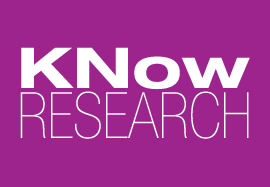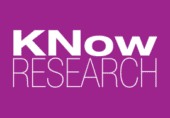Intention Setting for the New Year: Get Active about Listening
Here at KNow, one of our intentions for 2020 is to nurture a spirit of curiosity for our clients. And one of the very best ways to foster that spirit is to help our clients practice active listening.
When it comes to observing fieldwork, it can be easy to fall into a trap of passivity, whether it’s multitasking on emails while diving absentmindedly into a bowl of M&Ms in the viewing room during focus groups, half-heartedly logging into an online research community while juggling competing priorities (or forgetting to log in at all!), or quietly lurking in the shadows during a shop-along.
However, when client observers are provided with clear, active listening objectives, not only does it help them stay attentive, present and intentional, it leads to better research and better outcomes every single time.
Here are 4 fun, easy and effective activities we use with clients to encourage active listening during fieldwork.
#1 Bullseye!
During focus groups, one activity we invite our clients to play in the backroom is Bullseye. This entails drawing a bullseye chart on a large easel sheet or butcher paper and hanging it up on a wall in the viewing room.
Each circle in the bullseye represents a relevant research question or parameter. In the center of the bullseye, for example, is the core research question or learning objective. The middle and outer circles are labeled with secondary and tertiary research questions. However, the possibilities of Bullseye are extensive!
- Other bullseye representations might include placing “consumer insights” in the center circle, “competitive insights” in the middle circle, and “category insights” in the outer circle.
- Or label the center of the bullseye as the“AHA!“ for capturing surprising insights and new learning, the middle ring as “YUH-HUH” that affirms relevant learning that has also been observed in previous research, and the outer ring as “NUH-UH” for learning that may be interesting, but not particularly relevant or influential to the current objectives.
Once the Bullseye parameters have been recorded prior to the onset of the first group, each backroom observer receives a packet of sticky notes. Observers are invited to capture any evidence they hear during the groups that addresses the circles in the bullseye and to place their sticky notes accordingly along the way.
At the end of each group, the Bullseye chart and sticky notes become the focal point of the debrief conversation. Walking through the stickies within each circle of the bullseye can help identify where the learning is especially rich and where knowledge gaps may still exist so that the research approach can be adjusted accordingly ahead of the next group to ensure all key questions and hypotheses are fully addressed.
#2 Thinking Caps
When there are multiple clients observing fieldwork, it can be helpful to assign each client team member a specific ‘hat’ to wear throughout the course of the research.
For example, someone (or a few people) may be placed in charge of wearing the “Reporter Thinking Cap” to capture great quotes during the research, while another few folks wear the “Detective Thinking Cap” to captures ah-has, and a few others put on the “Science Thinking Cap” to capture hypothesis-confirming statements.
This exercise can also easily be paired with the Bullseye exercise, by assigning each client observer a specific bullseye circle to tune into during the fieldwork.
#3 Top 3
When conversing with research participants in their homes, while shopping, or in other 1-1 settings, oftentimes we ask client observers to use their phones or notepads to record their top 3 quotes from the interview, top 3 most interesting or surprising learnings (as it relates to values, motivators, detractors, shopping behavior, etc.), and/or top 3 overall insights or takeaways.
Sometimes we’ll even pose the question: if this was the only interview we were conducting, what are the top 3 action steps you would take as a result? Asking our clients to capture their “top 3” helps them to think critically while also trusting their professional instincts in order to prioritize what really matters to the business.
Top 3 works well to guide a debrief conversation between 1-1 interviews, but it can work great for just about any type of consumer conversation, such as focus groups, or even multi-day discussion boards and diaries fielded with larger groups of consumers via mobile or other electronic devices. Because online qualitative research can produce a fire hose of output that can be intimidating, confusing, and time-consuming for client teams to absorb, we often recommend pairing up a client to immerse in a single participant (or just a few participants). Then, at the end of each day of online activities, we invite clients to submit their Top 3s based on who they observed and use that output to get clear on the most relevant and actionable learning.
Top 3 is also a terrific ‘finale’ debrief activity to complete once all research has been completed. It can be fun and informative to ask clients to submit their Top 3s via a Google form or other client-approved and client-friendly electronic survey tool at the end of all fieldwork, and share the summarized output with the team in a tangible way in a next-day debrief, using the results as fuel to help shape the final summary deliverables.
#4 Test Drive
When it comes to diaries and discussion boards, it can be a lot of fun to invite client teams to put on their consumer hats and take the methodology for a Test Drive. Timing, topic, and budget permitting, client teams then complete some (or all) diary or discussion board exercises, whether it’s logging a food diary for a few days or sharing their own personal photos and experiences. Then, the KNow Analytics team can compile a topline readout based on the test-drive.
Inviting clients to put on their consumer hats and pilot the methodology can be a great way to help get them in the consumer mindset and excited about the fieldwork, while also offering an opportunity to finetune the hypotheses and the research tactics prior to fielding among recruited participants.
What’s your intention for 2020?
Our intention in 2020 (and always!) is to help our clients get the most out of their research investment, and to stay curious, be fully present and have fun along the way. What are your intentions for 2020? We’re here to help you stay on track!
If you’d like to read more about active listening, check out Jackie’s recent post on Listening Effectively

